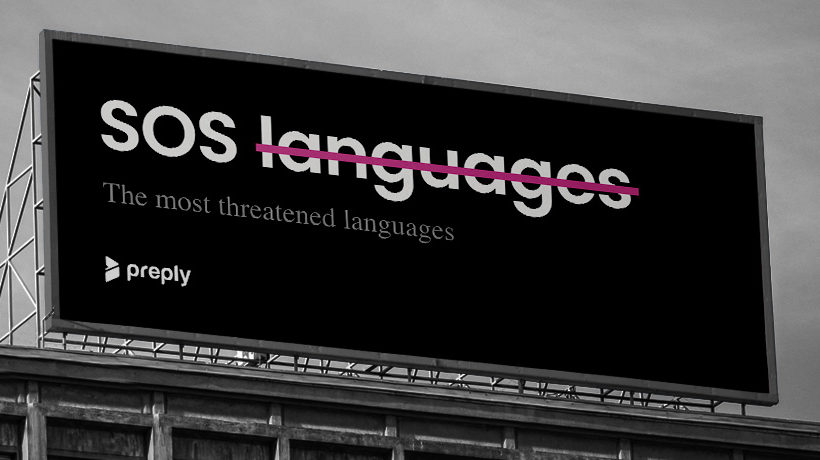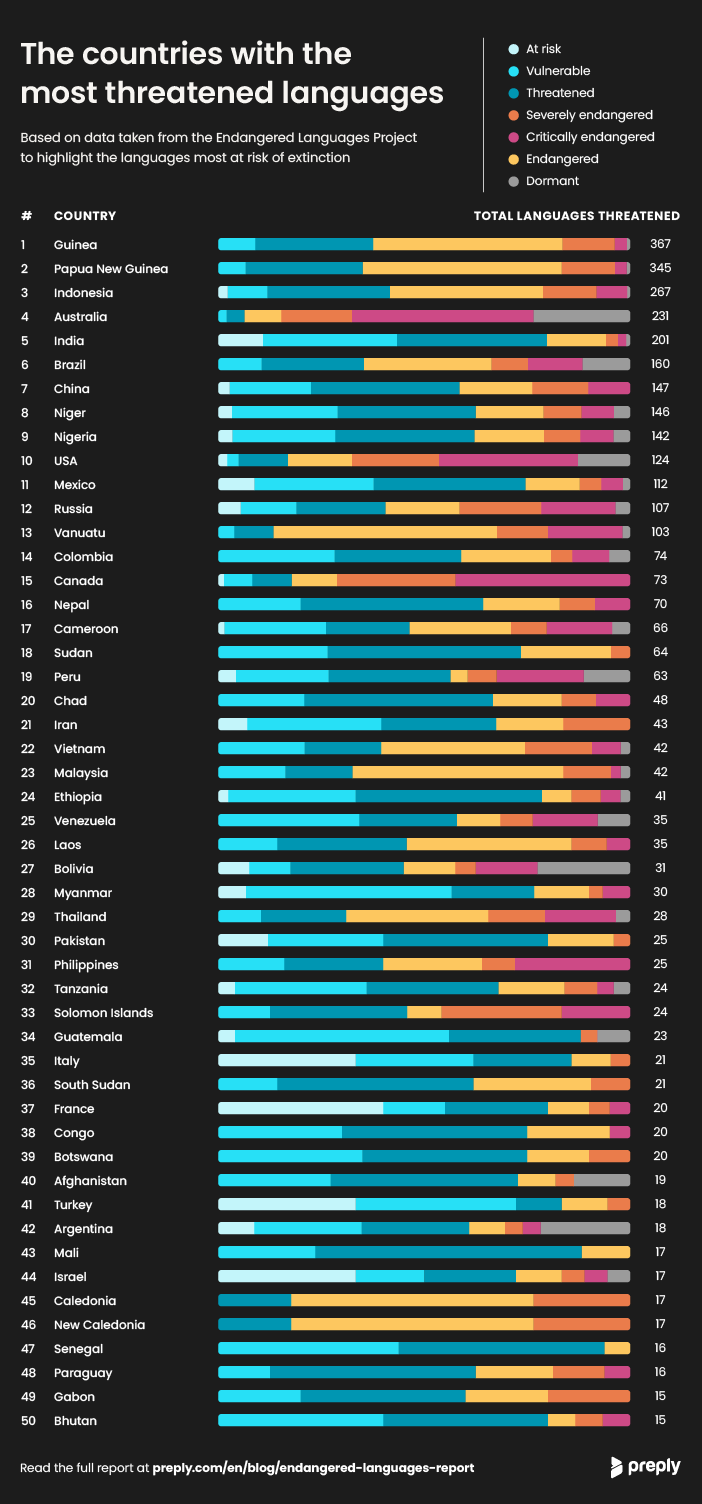SOS: These Languages Are Most Endangered in the World

- Regional patterns of endangered languages
- Number of speakers per endangered category
- The most endangered languages (From critically endangered to at-risk)
- Awakening languages
- Non-endangered languages with the most international growth
- 5 Endangered languages (and how you can help):
- How you can help save endangered languages:
- Methodology
To combat the decline of local languages and dialects, we’ve commissioned a report on the most endangered languages as well as selected several of them to highlight – in the hopes of reigniting awareness and interest in them.
We’ll also be looking at which regions of the world have the most endangered languages as well as what languages are taking over. Of course, with thousands of languages in danger of extinction, there are countless ones we could focus on; however, we’ve selected six that were, at one point, widely spoken but have since seen a rapid decline.
Endangered languages around the world
Before we look at individual languages, let’s take a look at trends and patterns in endangered languages.
Accuracy of the data varies depending on the country, process, and an individual respondent’s willingness to self-report. For that reason, certain languages exist in a gray area where, broadly speaking, we know they’re endangered but cannot always pinpoint absolute numbers or trends. Nevertheless, looking at the list of endangered languages as a whole, there are a number of patterns from which we can derive solutions and future revitalization strategies.
Regional patterns of endangered languages
Taking all of the available language data into account, we can see which regions have the highest number of individual languages at some point on the endangered spectrum. Specific reasons vary by language but, broadly, regions with the highest number of endangered languages share some common threads – most notably the impact of globalization on previously remote communities.
Even in places where native speakers are attempting to preserve language, socioeconomic pressures continue to impact younger and working-age populations – who are prioritizing learning languages that make it easier to find work over those that would preserve their heritage.
- Australia has the highest number of critically-endangered languages: 133¹
- The Pacific has the highest number of endangered languages: 250¹
- Africa has the most threatened languages: 217¹


Learn a language with personalised 1-on-1 classes with our expert tutors from all over the world
Number of speakers per endangered category
To help readers understand the distribution of speakers among each endangered category, we’ve combined every language detailed in the Endangered Languages Project on the spectrum and tabulated the total number of speakers:
The most endangered languages (From critically endangered to at-risk)
There are thousands of languages that are endangered but, in an effort to educate readers on the differences between these categories, we’ve compiled the ten-most threatened languages within each category for review. Again, it’s important to note that there are not finite population cut-offs for when a language would belong in one category over another – as rate of decline, sociopolitical influences, and age of the speaking population, among other factors, also impact categorization.

Learn a language online with our free learning materials.
Awakening languages
In spite of the decline we’re seeing in many languages, inspiration and hope comes from seeing that languages can bounce back. Awakening languages might not outnumber the amount of endangered ones (at least not yet) but they provide an encouraging sign that, with the right revitalization efforts and resources, a language can bounce back from near-extinction.
One such example is the Kaurna language, based out of Australia, which effectively went extinct when the last living speaker died in 1929. However, revitalization efforts resuscitated the language starting in the 1980s – by way of several different preservation means: creating original songs, developing a formal dictionary, and official language-learning programs. The work brought the total number of speakers to nearly 50 in recent years (with varying degrees of fluency) and while revitalization continues, the work remains a slow and meticulous process.
Additional languages considered to be awakening, include:
- Bering Aleut
- Palawa Kani
- Barbareño
- Natchez
- Taungurung
- Soyot
- Wampanoag
- Chiquimulilla Xinka
- Siraya
Non-endangered languages with the most international growth
Conversely, we also took a look at the languages that, due increasing external trade among previously isolated communities as well as the influence of social media and pop culture among younger generations, are becoming the dominant languages across the world.
Considering the benefits of learning English or Mandarin, for example, in parts of the world where international trade is super-charging population growth and increasing quality of life for many, it’s no surprise to see the languages of business at the top of the list.
While there isn’t a one-to-one correlation between increases in globalized languages and the decreasing population of endangered languages, there’s no doubt the expansion of these highly-spoken languages, at the center of international trade and commerce, can produce a decrease in local dialect populations.
5 Endangered languages (and how you can help):
Determining the most endangered languages in the world is a matter of perspective – and how you define “most endangered”.
Why? Because a case can be made for either of the following as “most endangered”: a relatively obscure language with only a few living speakers or a once-widespread language that, while it still has hundreds or even thousands of speakers left, has seen rapid decline.
Which is more endangered? Despite the importance of language (especially those rooted in rich cultural traditions that are also in decline), it’s impossible to highlight and save them all. Nevertheless, we’ve selected a handful in the hopes that spotlighting them will call attention to opportunities to support and learn languages in your local area.
Endangered Language: Welsh
Primary Location: Wales
Current Speakers: 562,000
Status: Vulnerable
The Welsh language originated from Brittonnic roots – without a clear emergence point – but language’s evolutions are actually marked: from Primitive Welsh (dates unknown), Old Welsh (9th – 11th centuries), Middle Welsh (12th – 14th centuries), to Modern Welsh (16th century – present).
While Welsh remains vulnerable to extinction, there is hope of revitalization. If we examine the last century, census data suggests that while the population of Wales has grown, the percent of Welsh-speakers decreased significantly (down from 50% in 1901 to 20.7% in 1971); however, the percentage of Welsh speakers has remained relatively stable (around 19-20%) for over 50 years. Unlike a lot of endangered languages, fluency in Welsh provides added employment opportunities – and speaking the language is viewed positively (as opposed to a sign of poor education). Conservation efforts also play a significant role in stabilizing Welsh language erosion but it is education programs directed at school-age children (especially Welsh-only institutions) that have led to widespread revitalization.
Today, 30% of children aged 3 – 15 can speak Welsh – whereas only 10% of older adults aged 55 – 64 can speak the language. For that reason, while Welsh remains vulnerable, there’s reason to think fluency can continue to improve in the coming years. In fact, the Welsh government has set a goal of reaching 1 million fluent speakers by the year 2050.
Endangered Language Profile: Lakota (aka Teton Sioux)
Primary Location: North and South Dakota
Current Speakers: 2,000
Status: Endangered

A variation of the Sioux language, Lakota (aka Teton Sioux) was once the primary language of the Lakota people; however, despite a population of 170,000 Lakota-identifying people, there are only 2,000 fluent Lakota language speakers in the world today.
The Teton Sioux language decline was part of the broader effort by the United States government throughout the 1800s to assimilate Native Americans into the country’s growing non-Native culture. Lakota children attending Indian residential schools were discouraged (by way of beatings and withholding food) from speaking Lakota – as were adults, who were more likely to find work if they could speak English. While members of the Lakota community attempted to maintain the language within families and cultural hubs, it wasn’t until the late 1960s and mid-1970s that formal revitalization efforts were introduced to save Lakota from extinction.
Since that time, the Lakota have developed numerous programs to provide opportunities for Lakota language learning – including the Lakota Language Education Program (with the mission of developing new Lakota language teachers that can educate new generations and the existing population in Teton Sioux). Still, with just over 1% of the Lakota people speaking the language at present, Lakota has a long and challenging road ahead – before it could be considered safe from extinction.
Endangered Language: Gaelic
Primary Location: Ireland and Scotland
Current Speakers: 57,000
Status: Endangered

Depending on where you live, the term “Gaelic” can mean different things: Gaelic can refer to the Scottish Gaelic language, specifically, or as an umbrella term for a series of languages (including Irish, Scottish Gaelic, and Manx) that evolved around Ireland, Scotland, and the Isle of Man – all of which exist in some degree of vulnerability.
For our purposes, we’ll be focusing on the group of languages – which, as of 2011, only had 57,000 speakers collectively. This is a small, but still notable, decrease from the number of speakers reported in the 2001 census: 59,000. In 2011, an additional 20,000 people reported they could understand but not speak, write, or read Gaelic – suggesting that a lack of formal education and ongoing support for Gaelic languages is one of the chief challenges to preventing their extinction.
Both Irish and Scottish Gaelic have seen increased conservation efforts but these are largely limited to laws acknowledging Gaelic, alongside English, as recognized state languages – falling short of some well-organized and heavily-funded efforts to restore other languages around the world.
To that end, Manx actually went partially-extinct when the last native speaker died in 1974 but has, in the time since, been kept alive by way of preservation efforts – but without significant hope for native revitalization.
Endangered Language Profile: Inupiaq
Primary Location: Alaska and Canada’s Northwest Territories
Current Speakers: 2,000
Status: Severely Endangered

A member of the Inuit language family, Inupiaq is most often associated with the Northern coast of Alaska as well as Canada’s Northwest territories – making it one of Canada’s most endangered languages.
Similar to Lakota, Inupiaq saw significant decline following efforts by the United States and Canada to assimilate first-nation communities into English-speaking culture. In both the U.S. and Canada, English-only residential schools forced Inuit youth to renounce Inupiaq; meanwhile, throughout the 1900s, nearly all jobs in Alaska and the Northwest Territories relied on English fluency, with no employment-related benefit to speaking Inupiaq. In time, fluency among much of the adult Inuit population decreased substantially.
Today, due to an aging population of fluent speakers, Inupiaq is considered “extremely endangered” – with both a relatively low number of Inupiaq speakers (2,144 as of 2007) as well as few Inupiat-identifying people left (roughly 20,000). Organized conservation of Inupiaq is underway but these efforts have largely been led at the community level – and, despite meaningful progress, Inupiaq will need a significant boost in fluency among younger Inuit people to be successfully revitalized.
Endangered Language Profile: Cornish
Primary Location: Cornwall
Current Speakers: 557
Status: Awakening

Similar to Welsh, the Cornish language has roots in Brittonic and grew in prominence for nearly 1,000 years – reaching a speaking population of 39,000 in the 13th century. Unfortunately, social and religious pressures throughout the following 200 hundred years would critically impact widespread adoption of Cornish.
One of the most notable turning points for the language was the passing of England’s Act of Uniformity in 1549 – which certified the English Book of Common Prayer as the only allowable worship text in the region (effectively outlawing non-English-speaking worship altogether). The act led to the Prayer Book Rebellion that same year – which resulted in the deaths of 4,000 protestors.
The defeat left non-English speakers demoralized and fearful of additional reprisals – which lead to many Cornish people distancing themselves from the language to prove fealty to England. Declines continued and Cornish officially went extinct in the 1800s.
Nevertheless, despite a relatively small population of speakers during its prime, Cornish has been a fortunate focus of revitalization work – thanks to carefully organized efforts that have standardized the Cornish alphabet and unified competing variations of the language (culminating in amStandard Written Form in 2008). While Cornish remains at risk of extinction, it is now considered an awakening language – albeit one that will need ongoing revitalization support for many more years.
Endangered Language: Louisiana French (aka Cajun French)
Primary Location: Louisiana
Current Speakers: 130,000
Status: Endangered
Despite a significant number of living speakers, Louisiana French is one of the United State’s most endangered languages. The language started as regional variations of French in the 1700s – as French-speaking voyagers from all over the world began settling in the Louisiana territory.
By the mid-1800’s, the dialects had consolidated into Louisiana French; however, as language protections began to ease, Louisiana French began a slow decline – one that rapidly accelerated when French-speaking was banned altogether from schools in 1921. The impact of the ban was far-reaching: it not only discouraged children from learning the French dialect, it stigmatized Louisiana French – associating the once-celebrated language with a lack of sophistication and poor education.
While some French speakers pushed back, increasingly harsh rules (including corporal punishment) used against French-speaking children and social stigmatization that discouraged French-speaking adults both resulted in signficant decline of Louisiana French, taking the total speaking population (estimated to be over 1 million in the late 1960’s) down to roughly 130,000 as of 2011.
Organized conservation efforts began to take shape in 1968 with the formation of The Council for the Development of French in Louisiana (CODOFIL) which was tasked with doing whatever the group could to preserve and teach French-speaking in the state. Conservation has helped slow the decline; yet, many of these efforts rely on teaching children more conventional versions of French – meaning that Louisiana French, itself, is still at risk – even if French-speaking within Louisiana has seen renewed support in recent decades.
How you can help save endangered languages:
So, how can you help? There are as many solutions to saving endangered languages as there are languages in need of saving.
Custom solutions will be needed in certain cases but we’ve put together a few easy ways to get involved and help revitalize a language near (or dear) to you:
- If you are a non-native speaker, educate yourself on endangered languages in your area and support, either with your time or financial resources, organized efforts. Even if there are no endangered languages in your area, learn any new language! Whether you learn Spanish, French, English, or Japanese, investing time in learning to speak a new language will give you a better appreciation for why preserving endangered languages is so important.
- If you are a native-speaking parent, immerse your children and family in your language at an early age – as well as seek out local opportunities and organizations that are working on revitalization.
- If you are an educational institution, consider offering these languages as part of the curriculum (or even as part of an extracurricular club) – making it easier to connect people who want to learn a language with other students and organized coursework.
- If you are a government body or politician, offer support programs to people who have recently moved to your area – so they can learn your local languages. Additionally, and possibly most importantly, fund language-learning programs and advocate for revitalization efforts.
As globalization and international trade expand, languages on the endangered list will continue to face challenges and pressures of decline. To that end, awareness and organized education have become proven strategies in revitalizing endangered languages; though, these efforts must be inline with the highly-customized reasons and factors that have led to a specific language’s decline.
More than anything, it is essential that conservationists be proactive, given that native speaker populations are heavily weighted toward aging groups and training younger generations to be fluent takes time – time that not all of these languages have left.
Methodology
Utilizing data taken from the Endangered languages project we highlighted the languages which were most at risk of extinction. Additionally, we took a deeper dive into specific regions to compile interesting data regarding localized languages and worldwide trends.
A variety of factors make it difficult to get exact numbers for any one endangered language – given that census data is only collected every 10 years in most countries (while many countries are even less frequent or do not have a formal census process at all).
Lastly, we incorporated additional information from local government sources – where data was available with a higher level of frequency than every 10 years.
Sources
- Data Collected from: https://www.endangeredlanguages.com/#/4/47.513/-1.473/0/100000/0/low/mid/high/unknown.
- https://www.endangeredlanguages.com/lang/5871
- https://www.endangeredlanguages.com/lang/10429
- https://www.endangeredlanguages.com/lang/2052
- https://www.scotlandscensus.gov.uk/census-results/at-a-glance/languages/
- https://www.endangeredlanguages.com/lang/2369
- https://www.endangeredlanguages.com/lang/4050
- https://www.endangeredlanguages.com/lang/10931
- https://www.lingq.com/en/learn-english-online/courses/20988/the-cornish-language-22141/
- https://academickids.com/encyclopedia/index.php/Prayer_Book_Rebellion
- https://www.celtictitles.com/blog/celtic-language-statistics-2022/
Next article

Study shows Americans are becoming less effective communicators
We surveyed over 2,200 Americans on their worst communication habits, from constant interrupting to scrolling on our phones when we should be listening.
Previous article

Language analysis: The angriest U.S. politicians on Twitter
Using a Natural Language Processing model, we did a sentiment analysis of thousands of tweets from high-profile U.S. politicians to find out who’s angriest on Twitter.







